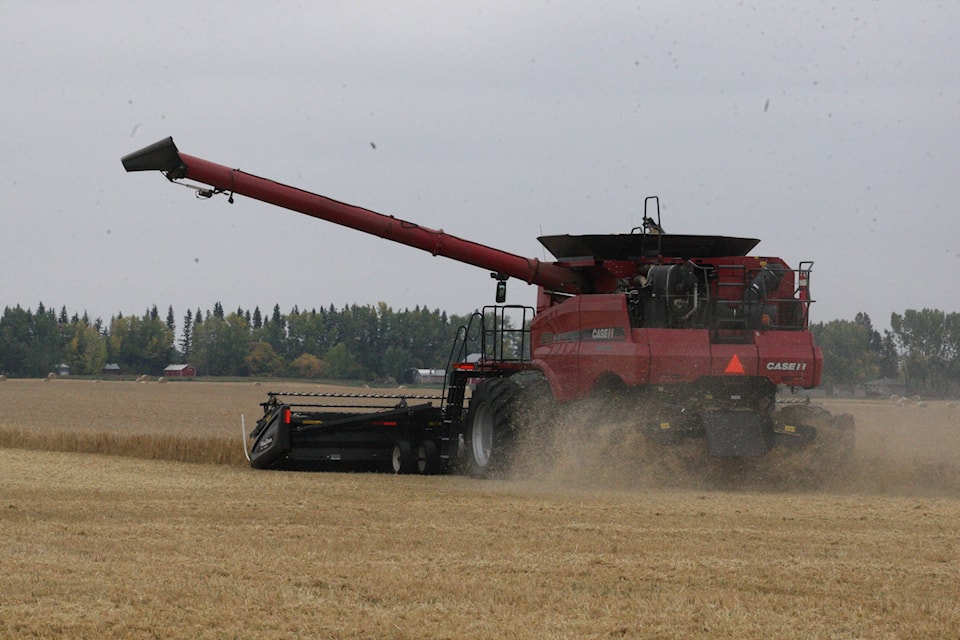Central Alberta farmers are mostly faring better than a lot of producers across the Prairies but the heat wave and lack of rain means yields will be down.
It will be a disappointment for many farmers, who were seeing strong commodity prices and early signs it could be a good year.
Pricing and high yields combined last year, but it’s a combination that does not come around that often — and it does not look like this year will be a repeat.
“With markets this strong and you just don’t have it in your fields, it’s heartbreaking,” said Cody McIntosh, Red Deer County’s agricultural services manager.
The lack of moisture has been an issue across Alberta for weeks. In central Alberta, storms blew through and brought up to two inches of rain in some parts of the region early this month. But it was hit and miss and some did not get the moisture.
On the plus side, provincial crop growing condition rated good to fair in central Alberta has only dropped about 15 per cent so far, much lower than other parts of the province where the percentage of crops rated good to fair topped 30 per cent.
“The entire province is in a moisture deficit right now and getting lower,” he said.
“Red Deer County is faring a little bit better than some but there is going to be a lot of pressure coming now with heat-stressed crops and drought-stressed crops. And now we’re seeing things grasshoppers coming, which is going to be the next challenge.”
The smoky conditions are helping some areas, especially in southern Alberta, because it has boosted humidity levels. It has also shaved a few degrees off the daily high temperatures, which is also a plus.
“It’s not like we need more sunlight and more heat at all at this point,” he added. “It is hard to tell with the amount of heat and sun and light we’ve had whether crops are past the point of no return.
“Is moisture going to help at this point? Maybe not.”
For flowering crops, the heat stresses the plants, which means fewer seeds are produced in the pods — which means lower yields.
“I would say last year at this time everything was above average and doing really well. At this time, guys are bracing for the worst. They are hoping to be average but it’s probably going to end up a lot worse than that.”
For crops used to feed livestock, such as hay and alfalfa, rain will be more of a help. The first cut of hay came off fine in early July, but the fate of the second cut will depend a lot on what moisture arrives over the next month or so. Second hay crops are usually cut around the end of August or early September.
Poor hay crops hurts cattle producers because they must turn to buying other feed earlier, which boosts demand — and often prices.
Sylvan Lake-area canola farmer Mike Ammeter said the season started off promising but it will not be as good a year as some hoped.
“We were setting up for a pretty good year. Prices were good. There was optimism.
“How quickly that changes.”
It could be a lot worse though.
“It’s kind of hard to complain to listen to so many people from across the Prairies. Yeah, we could use some rain, but we’re not looking at a crop failure or a disaster. It’s just a little lack of moisture right now.
“I’ll take it, compared with a lot of my other friends and farmers across the Prairies,” he said, adding areas of southern Alberta have also been harder hit than central Alberta.
“I know there are places in southern Alberta where the combines are out. That’s crazy — in July? But everything is just dried right out.”
Saskatchewan Agriculture reported that the heat and dry conditions had caused many crops to mature early and yields will be down there. In the Swift Current area, a severe drought has been declared.
In Manitoba, two rural municipalities have now declared a disaster after a week of scorching temperatures that continued into the mid-30s C last weekend. The rural municipality of Armstrong, north of Winnipeg, declared a disaster on Friday less than a week after the neighbouring rural municipality of St. Laurent declared its own.
